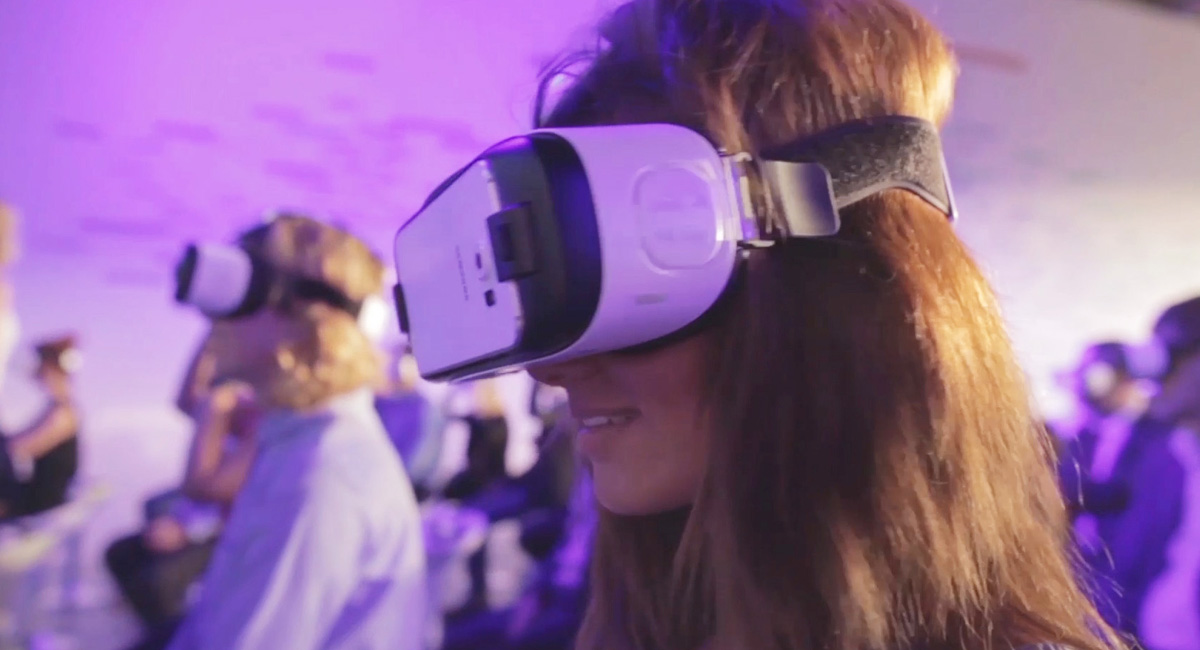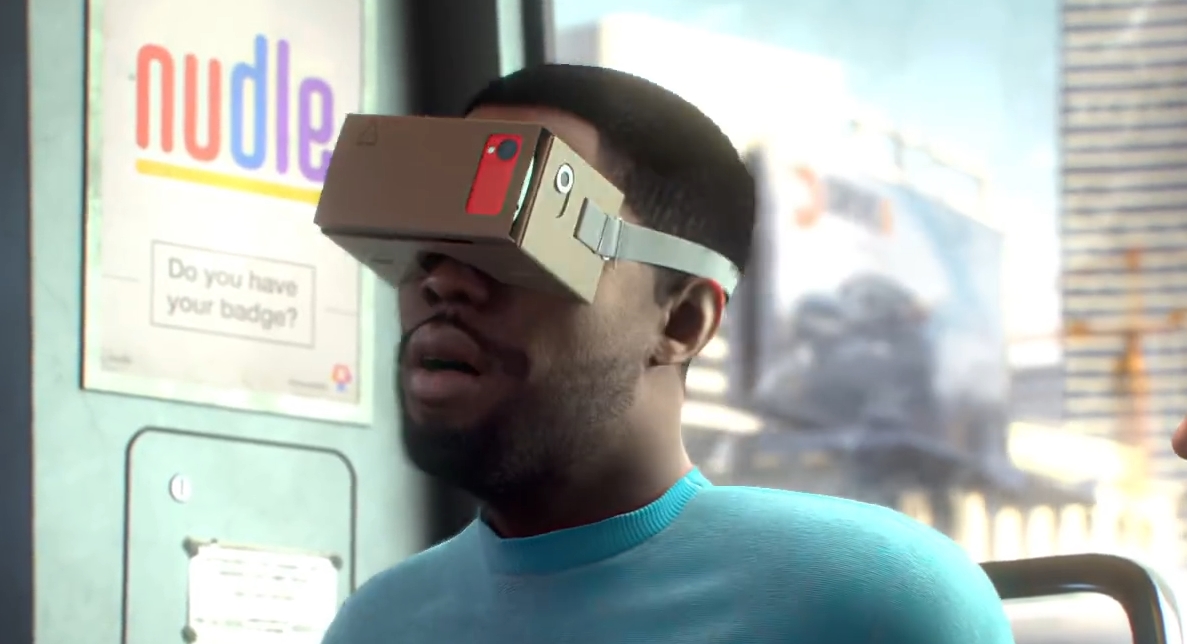“By placing our physical bodies in the center of our extended nervous systems via electronic media, we initiate a dynamic by which all extensions of our bodies can be translated into information systems“.
Marshall McLuhan. 1964
Virtual Reality + 3D Internet
Alejandro Sacristán
The Immersive Virtual Reality was born in the Sixties with Ivan Sutherland: “Virtual Reality is the final screen, a place in which the computer can control the existence of matter”. It was 1965.
The First Wave of the 90’s
Virtual Reality would emerge later as the star of computer graphics and exploded in the early 90s when the first wave of Virtual Reality hit the mainstream.
At the ArtFutura 1990 “Virtual Reality” festival, the audience would experience for the first time in Europe the Virtual Reality interfaces. It was in Barcelona in January 1990 and Rebecca Allen wrote: “In the XXI century the progressive sophistication of technology allow us to create known and unknown worlds that surround us and draw in a way never experienced before. Such environments we call “virtual realities”.
The Second Wave
We are now inmersed in the second wave of Virtual Reality. And it is inevitable for ArtFutura to retrace its steps and reflect with the distance that time offers.
What is Virtual Reality today? It is a new immersive communications fabric, a cyborg extension of the Human Collective. The continuation of paradigms such as printing, Internet and Intelligent Communication in mobility.
Virtual Reality will have an impact as important as previous revolutions in communication and transmission of knowledge. And will change everything,We have gone through the screen, we are insid the scene and we participate in it. It’s another dimension.
Sharing
Virtual Reality in the 90s triumphed in the big stage of immersive applications: Industrial Virtual Reality, Scientific Virtual Reality, Aerospace Virtual Reality, Medical Virtual Reality.
Virtual Reality also triumphed on our flat screens, monitors and computer and TV screens.
We were users psychologically immersed in the scenes of an interactive 3D game in real time.
But we were not still, inside of it.
Consolidation
Now in its consolidation, Virtual Reality goes beyond. It no longer needs the name “immersive” because what defines this new way of Virtual Reality is – as expressed by Oculus’ Michael Abrash – the sense of presence, to feel inside a new world, a synthetic reality you perceive as real.
Today we are building a 3D Internet, a real and digital space at the same time, a place that will be everywhere and we will be in it.
Virtual Reality places us at the beginning of a new way of social interaction: communicating, working, playing and growing as human beings
The Next Reality
Pau Waelder
In 1990, the first edition of the festival ArtFutura explored its possibilities and echoed the effusive attention given to a medium that, as Timothy Leary then said, “allows the individual to become reality-architect, cyber-artist, screen-writer, screen-star, screen-director”.
The dreamy enthusiasm of Leary is repeated 26 years later in the speech of Chris Milk, although there has been substantial changes in the two and a half decades that separate them.
The director of music videos presents the products of his company Within (before VRSE), a production company of audiovisual content, co-founded with the artist and designer Aaron Koblin, that has recently received funding from various investors worth 12.56 million dollars. The audience at the TED lecture series ($ 8,500 per person to attend) experience Virtual Reality through some cardboard viewers containing a smartphone with the app Within. Virtual Reality in 2016, is no longer a futuristic utopia, but a growing industry.
“There are two problems: hardware and software,” says Jaron Lanier, a pioneer of the VR, when asked why this technology has taken decades to spread beyond specialized users in scientific laboratories, medical and engineering.
Virtual Reality devices must occupy the field of view of the user and allow him to move his head, therefore its size and weight is an essential factor. The viewer developed by Sutherland and Sproull in 1968 was so heavy that it had to hang from the ceiling. The devices developed by Lanier and other former employees of Atari VR laboratory in the 80s were also difficult to use. We would have to wait until the full development of the smartphone, which integrates a processor, screen, gyroscope, speakers and Internet access in one small, lightweight device to be able to use a hardware that could be placed within the viewer.
Oculus Rift
In 2010, the entrepreneur Palmer Luckey launched the first prototype of its Oculus Rift viewer, using a smartphone, and renewed the interest in this technology that can finally reach the public. Four years later, Facebook buys Oculus for 2,000 million dollars, starting the growing trend of huge investments in companies VR.
Currently we get offered in the market (in some cases, as pre-orders) nearly a dozen viewers of Virtual Reality, with others in development. Paradoxically, hardware and software are being developed faster than the content they have to offer to their users, as Aaron Koblin says: “There is so much hype and enthusiasm, while there are hardly any content yet … but I think this will be a great year. “
Companies like Within, together with many other game developers, are focusing on providing that content to a growing number of artists experimenting with the creative possibilities of this technology, betwen them Jon Rafman or Rachel Rossin (first artist in residence of the Virtual Reality program at the New Museum in New York), following in the footsteps of pioneers like Char Davies.
Augmented Reality in the Real World
Virtual Reality and Augmented Reality technologies have the potential to introduce profound changes in our perception of reality and our interaction with the environment. In this sense, they should be seen as much more than mere tools and we should consider the cultural and social aspects that are generated around them.
As Myron W. Krueger said almost thirty years ago, “We are incredibly accustomed to conceive that the only role of technology is to solve problems. It also creates concepts and philosophy”. The Virtual Reality pioneer also warns that the technology “will enter every house and office and will intercede between us and the information and experiences that we receive […] we must recognize this if we want to understand and be able to choose what we’ll become, as a result of what we have created. “
As VR and AR are become more integrated into our daily lives, it will change the way we perceive and conceive reality, to the extent that it will not make sense to distinguish between virtual and real, but to talk about something in between. So maybe we should be creating the cultural context to help us understand it.
Notes
-
- Chris Milk: The birth of virtual reality as an art form. TED. Consulted at: http://www.ted.com/talks/chris_milk_the_birth_of_virtual_reality_as_an_art_form
- Timothy Leary (1990). Unlimited virtual realities for everyone! How we became amphibians. ArtFutura 90. Consulted at: http://www.artfutura.org/v2/artthought.php?idcontent=10&idcreation=65&mb=3&lang=En
- Within. Storytelling for Virtual Reality. Consulted at: http://with.in
- Angela Watercutter (2016, 16 de junio). VR Maker Vrse Gets a New Name –Within– and Millions in Funding. WIRED. Consulted at: https://www.wired.com/2016/06/vr-vrse-new-name-millions-funding
- Niall Firth (2013, 19 junio). Virtual reality: Meet founding father Jaron Lanier. New Scientist. Consulted at: https://www.newscientist.com/article/mg21829226-000-virtual-reality-meet-founding-father-jaron-lanier
- The most relevant viewers are: Oculus Rift (Facebook), HTC Vive (HTC y Valve), PlayStation VR (Sony), Cardboard (Google), Gear VR (Samsung y Oculus), OSVR(Intel y Razer, in development), Fove (Fove Inc and Microsoft, on pre-sale), HoloLens (Microsoft, in development) y Meta (Meta, pre-sale).
- Rachel Rossin – NEW INC. New Museum. Consulted at: http://www.newinc.org/rachel-rossin
- Immerscence. Consultado en: http://www.immersence.com
- Kevin Kelly (2016). The Untold Story of Magic Leap, the World’s Most Secretive Startup. WIRED. Consultado en: https://www.wired.com/2016/04/magic-leap-vr/
- Tilt Brush by Google. Consultado en: https://www.tiltbrush.com
- Myron W. Krueger (1977). Responsive Environments. AFIPS 46 National Computer Conference Proceedings. 413-33. Montvale N.J.: AFIPS Press.
- Google Glass. Consultado en: https://www.google.com/glass/start
- Magic Leap. Consultado en: https://www.magicleap.com
- Peter Rubin (2016, 16 June). Magic Leap’s next move? Bringing C3PO to your house. WIRED. Consulted at: https://www.wired.com/2016/06/magic-leap-lucasfilm
- Sander Veenhof y Mark Skwarek, MoMA DIY Day. Consulted at: http://www.sndrv.nl/moma
- The Invisible Pavillion. Consulted at: http://www.theinvisiblepavilion.com
- Katherine Cross (2016, 11 August). Augmented Reality Games Like Pokémon Go Need a Code of Ethics—Now. WIRED. Consulted at: https://www.wired.com/2016/08/ethics-ar-pokemon-go
- Myron W. Krueger (1977). Responsive Environments. op.cit.







